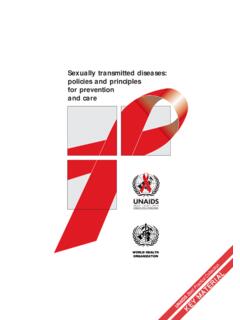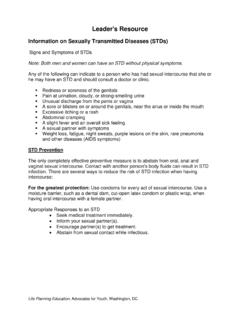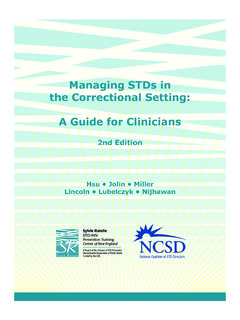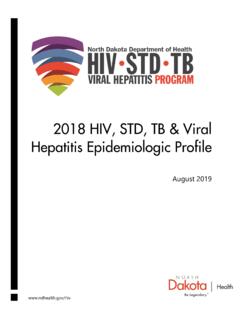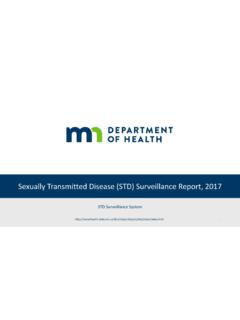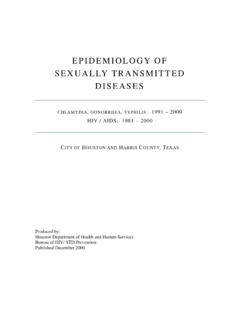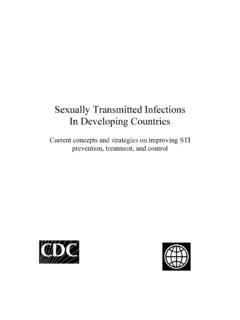Transcription of Sexually Transmitted Diseases, Part II: “Drips” & …
1 The Health Care of Homeless Persons - part I - stds : II - Drips & Discharges 131 Sexually Transmitted Diseases, part II: Drips & Discharges Noreen A. Hynes, MD, MPHG onococcal Urethritis. Gram stain of the urethral discharge in this man shows many polymorphonuclear leukocytes with intracellular Gram negative diplococci. Photo courtesy of the CDCS exually Transmitted diseases ( stds ) associated with discharges or drips are usually caused by one of three types of pathogens - bacteria, viruses, or parasites. One non-STD fungal infection, candidiasis, is seen frequently among active persons and is considered in this group.
2 Although inflammatory stds are classically associated with discharges, these infections cause a spectrum of disease from asymptomatic infection to an array of often overlapping syndromes that make clinical diagnosis alone inadequate for predicting the cause of the infection. Untreated or inadequately treated stds associated with discharges can have long-term adverse consequences, particularly for women and their fetuses and newborn infants. These inflammatory stds enhance the acquisition and transmission of human immunodeficiency virus (HIV).
3 Early detection, treatment, partner notification services, and education targeting behavior modification are critical components of interrupting the transmission of stds . Prevention and control elements must be rigorously and creatively pursued among certain at-risk groups, including guests in homeless shelters, to interrupt the ever-expanding hidden epidemic of stds . General Approach to Patients at Risk for STDsEvery Sexually active patient not in a long-term, mutually monogamous relationship who is seen in the clinic should be considered at risk for newly incident stds , both asymptomatic and symptomatic.
4 Whenever possible, a routine STD screening history and physical examination should be obtained on all at-risk patients, regardless of the presenting complaint. Contacts of patients treated for bacterial stds or trichomoniasis should be treated and offered screening for HIV infection, if indicated. Contacts of persons with viral stds should be tested for the presence of infection and offered screening for HIV, if indicated. Sexually active persons, with or without symptoms, should undergo diagnostic testing for treatable stds and be offered HIV counseling and testing.
5 Those with symptoms of stds should have further evaluations based upon the clinical syndrome noted at presenta-tion. Single dose, directly-observed therapy should 132 The Health Care of Homeless Persons - part I - stds : II - Drips & DischargesThe Health Care of Homeless Persons - part I - stds : II - Drips & Discharges 133be used for treatment when an approved regimen exists. Most of the STD clinical syndromes fall into two general categories: sores and drips/discharges . The approach to genital sores was discussed in the previous chapter.
6 This chapter will address stds associated with discharges or drips . Inflammatory stds Presenting as DischargesInflammatory stds can cause diffuse manifes-tations, many of which are gender-specific rather than pathogen-specific. Therefore, the associated syndromes will be grouped by gender for discussion of the clinical presentations, prevalence, complica-tions, diagnosis, and treatment, and follow-up. Prevention and control strategies will be discussed together after the clinical section of the chapter. The clinical syndromes for discussion include:Acute Inflammatory stds in Women lower genital tract inflammatory stds in women (vaginitis, mucopurulent cervicitis) upper genital tract inflammatory stds in women (pelvic inflammatory disease or PID)Acute Inflammatory stds in Men urethritis acute epididymitis I.
7 Acute Inflammatory stds in Women: A. Lower Genital Tract STDsVaginal discharge caused by a lower genital tract STD may be due to inflammation or infection of the vagina or the cervix, with vaginitis predominating. The presence of vaginal discharge should lead the practitioner to question the patient further about related signs and symptoms and should be followed by a directed physical examination that should include, at a minimum, inspection of the external genitalia and a bimanual examination. The patho-gens associated with vaginal discharge include: Neisseria gonorrhoeae, the causative agent of gonorrhea; Chlamydia trachomatis, the causative agent of Chlamydia; Trichomonas vaginalis, the causative agent of trichomoniasis.
8 Bacterial vaginosis, a disruption of the Table 1: Vaginal Discharge and Vaginitis FeaturesFeatureNormal FemaleVaginal FluidBacterial vaginosisTrichomoniasisCandidia vulvovagintitisDischarge Characteristics Amount Consistency ColorUsually scantFlocculant, non-homogeneousWhite or clearModerate to heavyHomogeneous; coats vaginal wallsGrey or whiteHeavyHomogeneous; often frothyYellow, green, whiteModerate to heavy Cheesy , clumpy, adherant plaques on erythmatous baseWhiteClassic symptomsNoneIncreased dischargeOdor oftenIncreased dischargeOdor oftenExternal dysuriaPruritis Increased dischargeNo odorSevere vulvar pruritisUsual secretion pH< > > < exam of secretionsSaline prepEpithelial cells: normal Organisms: Lactobacilli predominateSaline prepEpithelial cells: Clue cellsOrganisms: No/few lactobacilliSaline prepOrganism: Motile trichomonads10% KOH prepEpithelial cells: Lysed by KOHO rganism.
9 Budding yeast/pseudohyphae Whiff test outcomeNo odorFishy smellFishy smell at timesNo odor132 The Health Care of Homeless Persons - part I - stds : II - Drips & DischargesThe Health Care of Homeless Persons - part I - stds : II - Drips & Discharges 133vaginal floral ecology; Candida albicans, the causative agent of vulvovaginal candidiasis; herpes simplex of vaginitisThree common causes of inflammatory vaginitis are trichomoniasis, bacterial vaginosis, and candidiasis. Woman commonly present with a complaint of vaginal discharge or vulvar itching and irritation and may complain of the presence of a vaginal odor.
10 Bacterial vaginosis (BV) is caused by a disruption of the normal acid-rich vaginal flora. BV has only been shown to be an STD in women who have sex with women. Otherwise, it is considered a high-risk marker for the presence of an STD. Signs and symptomsA detailed history to obtain a good description of the vaginal discharge in terms of amount, odor, and the presence or absence of pruritis is essential to the diagnosis of vaginitis. An examination of the external genitalia, vagina and cervix is very important: vulvovaginal candidiasis (VVC) is most likely to be associated with vulvar pruritis, erythema, and a cheesy discharge; trichomoniasis usually has vulvar pruritis and a frothy green-yellow discharge that is malodorous; BV often has a watery malodorous is common and signs and symp-toms often overlap.


